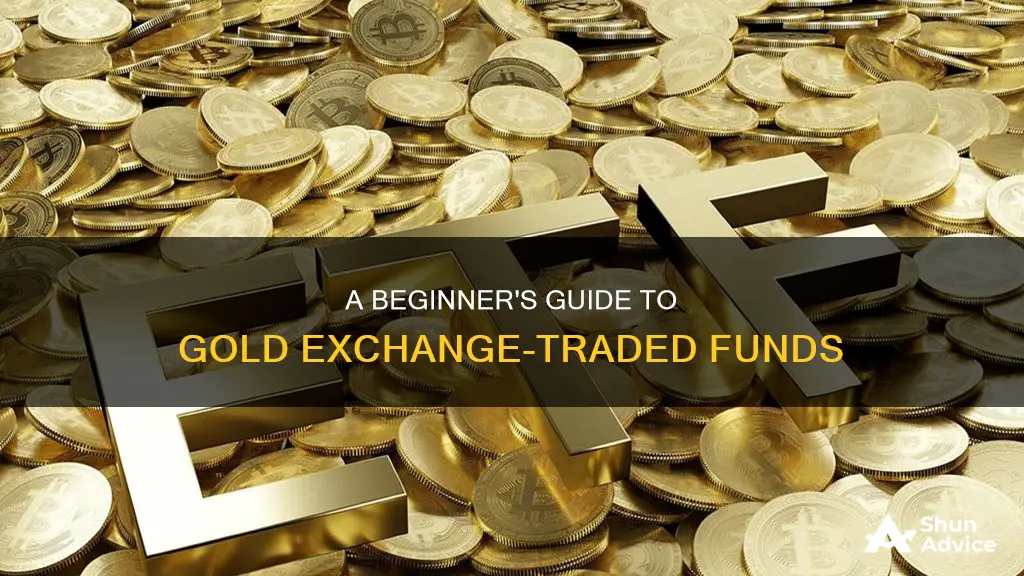
Gold exchange-traded funds (ETFs) are a popular investment option for those seeking to diversify their portfolios and hedge against market volatility and inflation. Gold ETFs provide investors with exposure to gold without the complexities and costs associated with purchasing and storing physical gold. In this article, we will discuss the benefits of investing in gold ETFs, the different types of gold ETFs available, and outline a step-by-step process for investing in gold ETFs, including important considerations to keep in mind. By the end of this article, readers should have a comprehensive understanding of gold ETFs and be able to make informed decisions about whether investing in gold ETFs aligns with their financial goals and investment strategy.
| Characteristics | Values |
|---|---|
| Gold ETF with the Lowest Fees | iShares Gold Trust Micro ETF (IAUM) |
| Gold ETF with the Best 1-Year Return | Invesco DB Precious Metals Fund (DBP) |
| Most Liquid Gold ETF | SPDR Gold Trust (GLD) |
| Gold ETF with the Lowest Expense Ratio | iShares Gold Micro ETF |
| Gold ETF with the Best Liquidity | SPDR Gold Trust |
| Gold ETF with the Best 12-Month Return | Invesco DB Precious Metals Fund |
| Gold ETF with the Highest 5-Year Annual Return | SPDR Gold Shares (GLD), iShares Gold Trust (IAU) |
| Gold ETF with the Highest 2024 YTD Performance | iShares Gold Trust (IAU) |
| Gold ETF with the Lowest Expense Ratio | GraniteShares Gold Trust (BAR) |
What You'll Learn

Gold ETFs vs. buying physical gold
Gold ETFs and physical gold are two very different ways to invest in the precious metal. Each has its own advantages and disadvantages, and investors should carefully consider their options before making a decision.
Gold ETFs
Gold exchange-traded funds (ETFs) are a popular way to invest in gold without having to deal with the physical metal. Gold ETFs are highly liquid, allowing investors to buy and sell shares quickly and easily through financial markets. The management fees associated with gold ETFs are generally lower than the combined costs of buying, storing, and insuring physical gold. Additionally, gold ETFs are typically more cost-effective and easier to buy, hold, and sell than physical gold.
However, it is important to note that gold ETFs do not offer investors ownership of physical gold. Instead, investors own shares in a gold fund that can be redeemed for their dollar value. The value of a gold ETF is tied to the price of gold, so investors can still benefit from the price movements of the metal.
Physical Gold
Physical gold, on the other hand, offers investors direct ownership of the metal. It is seen as the ultimate safe haven asset, having retained its value and purchasing power through centuries of human conflict and financial crashes. Physical gold also provides a tangible asset that can be easily exchanged for cash or other goods during times of economic downturn.
However, owning physical gold comes with additional costs related to storage, insurance, and dealer markups. It can also be difficult and costly to sell, as investors must find a buyer and may incur authentication costs.
Both gold ETFs and physical gold have their advantages and disadvantages. Gold ETFs offer higher liquidity and lower costs, while physical gold provides direct ownership of the metal and serves as a tangible asset during economic downturns. Ultimately, the decision between investing in gold ETFs or physical gold depends on the investor's individual needs and preferences.
Vanguard Funds: Smart HSA Investment Strategies
You may want to see also

How to find a gold ETF
Gold ETFs are exchange-traded funds that track the price of gold. They are a popular investment option for those looking to hedge against stock market uncertainty and inflation. Gold ETFs can be purchased through an online broker, just like stocks.
Step 1: Understand Gold ETFs
Firstly, it is important to understand what gold ETFs are and how they work. Gold Exchange-Traded Funds are commodity-based mutual funds that invest in gold assets, such as gold bullions or futures contracts. The price of a gold ETF is directly linked to the price of gold. For example, if the price of gold increases by 2%, the value of the gold ETF will also increase by approximately 2%.
Step 2: Research Brokerage Websites
You can typically find gold ETFs by searching for them on brokerage websites. Popular brokerage platforms include Public, Fidelity, and Charles Schwab. These websites will allow you to search for and compare different gold ETFs based on various factors.
Step 3: Compare Different Gold ETFs
When comparing gold ETFs, there are several factors to consider:
- Returns: Check the five-year returns of the gold ETF. Most gold ETFs are pegged to the spot gold price, so the returns should align with the movements in the gold price.
- Expense Ratio: This is the annual fee charged by the ETF and paid out of your investment in the fund. It is important to look for a gold ETF with a low expense ratio.
- Liquidity: The liquidity of a gold ETF refers to how easily it can be bought or sold without impacting the price. SPDR Gold Trust (GLD), for example, is known for offering good liquidity.
- Fees: Consider the total expense ratio (TER) of the gold ETF, which includes insurance premiums, storage costs, and management fees. iShares Gold Trust Micro ETF (IAUM) is known for having low fees.
- Holdings: Understand what the ETF holds. Some gold ETFs hold physical gold bullion, while others hold gold futures contracts or invest in gold mining companies.
- Risk: Consider the level of risk associated with the gold ETF. Leveraged gold ETFs, for example, use financial derivatives and borrowed money to bet on future price movements, making them riskier.
Step 4: Analyse Personal Investment Goals
Different gold ETFs may align with different investment goals. For example, if you are looking for a long-term investment, you may want to consider gold ETFs with strong historical returns and low fees. On the other hand, if you are looking for short-term gains, you may want to consider more speculative options.
Step 5: Consult Financial Advisors
If you are unsure about which gold ETF to choose, consider consulting a financial advisor or broker who can provide personalized advice based on your investment goals and risk tolerance.
By following these steps, you can find a gold ETF that aligns with your investment goals and helps you gain exposure to the gold market.
Retirement Fund Investment: Where to Place Your Money Wisely
You may want to see also

Analyzing a gold ETF before buying
Gold ETFs are a great way to gain exposure to gold without the hassle of physically buying, storing, and reselling the precious metal. When analysing a gold ETF before buying, there are several key factors to consider:
Five-year returns
Most gold ETFs are pegged to the spot gold price, so you should expect their returns to align with gold price movements. If the returns do not correlate with the gold price, this could indicate higher levels of risk or suboptimal fund management.
Expense ratio
The expense ratio is the annual fee charged by the fund, which covers management and administrative costs. This fee is paid out of your investment in the fund, so a high expense ratio will eat into your returns over time. Look for gold ETFs with low expense ratios to maximise your investment returns.
Management and storage fees
Gold ETFs that invest in physical gold will incur management and storage fees, which can affect overall returns. These fees are usually lower than the combined costs of buying, storing, and insuring physical gold, but it is important to consider them when analysing a gold ETF.
Liquidity
Gold ETFs offer higher liquidity than physical gold, allowing you to buy and sell shares quickly through financial markets. Consider the liquidity of the gold ETF and how easily you will be able to exit your investment if needed.
Diversification
Some gold ETFs invest solely in physical gold, while others may invest in a range of gold-related investments, such as gold mining companies or gold futures contracts. Diversifying your investment across a range of gold-related assets can potentially provide broader exposure to the gold market and different sources of returns.
Tax implications
The tax treatment of gold ETFs can vary depending on your location and the structure of the fund. In some cases, gold ETFs may be subject to capital gains tax when sold at a profit, while in other cases, they may offer tax advantages over physical gold investments. It is important to understand the tax implications of investing in gold ETFs in your specific jurisdiction.
Unlocking Opportunities: Investing in VC Funds
You may want to see also

Buying a gold ETF
Gold ETFs are a popular way to invest in gold without having to directly purchase, store and resell the precious metal. They are also a more liquid and low-cost way to invest in gold compared to buying physical gold.
Gold ETFs are exchange-traded funds that give investors exposure to gold. Some gold ETFs track the price of gold, while others invest in companies in the gold-mining industry. As with other types of ETFs, the issuing company buys stock in gold-related companies or purchases and stores gold bullion itself. Investors buy shares in the fund, whose value rises and falls with the underlying gold price or company stock value.
Step 1: Find a gold ETF
You can typically find gold ETFs by searching for them on your broker's website. If you don't have a broker, you can look for one online and open a brokerage account.
Step 2: Analyze the ETF
Before buying, it's important to research ETFs, just as you would research stocks. Here are some things to check before purchasing shares in a gold ETF:
- Five-year returns: Most gold ETFs are pegged to spot gold prices, so returns should align with gold price moves.
- Expense ratio: This is the ETF's annual fee, paid out of your investment in the fund. Look for a low expense ratio.
Step 3: Buy the gold ETF
You can buy gold ETFs through an online broker, just like you would buy a stock. One approach is to buy them regularly to take advantage of dollar-cost averaging.
Advantages of investing in gold ETFs
Gold ETFs offer several benefits over purchasing and stocking physical gold:
- Easier trading: The process of buying and selling gold ETFs is similar to that of any other equity-based fund. They are also much easier to liquidate and can be traded during working hours.
- No entry or exit loads: Gold ETFs do not attract any entry or exit loads, ensuring zero additional charges when buying or selling these funds.
- Tax benefits: Apart from capital gains tax, gold ETFs do not attract VAT or Securities Transaction Tax, allowing investors to save taxes on their investment.
- Less market risk: Gold prices usually do not fluctuate substantially, allowing the prevention of major losses even when returns on equities decrease significantly. Gold ETFs are available in variable denominations, making them ideal for all types of investors.
- Usage as collateral: Gold ETFs can be presented as collateral against a secured loan from a financial institution, providing more convenience than traditional hypothecation.
- Hedge protection: Gold ETFs can be used as hedge protection against a fluctuating market, making them an alternative to insurance in an investment portfolio.
Disadvantages of buying gold
Gold also has some drawbacks as an investment:
- Volatile price in the short term: Gold has retained its value over the years, but it has been susceptible to erratic moves in the short term.
- Hard to estimate the value: Some investors argue that, unlike stocks, valuations for gold can be tricky to estimate since it doesn't have earnings or cash flow metrics to analyze.
- No cash flow to investors: Gold doesn't generate cash flow, which is a turn-off for those looking for passive income like dividends.
- May be taxed as a collectible: Depending on the type of gold asset, profits from selling gold ETFs may be taxed as collectibles rather than ordinary investments, resulting in a higher tax rate.
- Better long-term returns elsewhere: While gold may perform well over shorter periods, investors can find better long-term returns by investing in a diversified portfolio of stocks or a stock ETF.
Liquid Fund Investment: Axis Liquid Fund Guide
You may want to see also

Benefits of investing in gold ETFs
Gold ETFs are a great way to invest in gold without having to deal with the physical commodity. Here are some of the benefits of investing in gold ETFs:
Easier Trading
The process of buying and selling gold ETFs is similar to that of equity-based funds, making it straightforward for individuals who are already trading stocks. Gold ETFs are also easier to liquidate and can be traded during working hours. Gold prices are publicly available on the stock exchange, providing transparency and allowing investors to track changes on an hourly basis.
No Entry or Exit Loads
Gold ETFs do not attract any entry or exit fees, resulting in zero additional charges when buying or selling these funds.
Tax Benefits
Apart from capital gains tax, gold ETFs do not attract VAT or Securities Transaction Tax, allowing investors to save on taxes. Physical gold, on the other hand, can make an individual liable to pay wealth taxes, especially if they purchase a significant amount of gold jewellery or bullion.
Less Market Risk
Gold prices typically do not fluctuate substantially, reducing the risk of major losses even when equity returns decrease significantly. Gold ETFs are available in variable denominations, making them accessible to all types of investors. Individuals can start investing with as little as one unit of the fund, which represents one gram of gold.
Usage as Collateral
Gold ETFs can be used as collateral against secured loans from financial institutions. This process is more convenient than traditional hypothecation and is significantly less time-consuming.
Invest HSA Funds: Long-Term Benefits, Tax-Free Returns
You may want to see also
Frequently asked questions
Gold ETFs are a type of exchange-traded fund that tracks the price of domestic physical gold. They are passively managed funds that invest in gold bullion.
Gold ETFs are ideal for investors seeking exposure to high-purity gold without the complexities of physical storage. They are also suitable for those who want to track and reflect the actual price of gold in real-time.
Investing in gold ETFs offers several advantages, including easier trading, no entry or exit loads, tax benefits, less market risk, and usage as collateral.
To invest in gold ETFs, you will need a Demat and a trading account. You can search for and select your preferred gold ETF scheme, choose the investment type (SIP or lumpsum), and proceed with the payment process.
Gold ETFs can be a good investment for those seeking exposure to gold without physical ownership. They offer flexibility, liquidity, and potential returns, making them suitable for diversification. However, they are not entirely risk-free, as their value can be impacted by market fluctuations, economic conditions, and geopolitical events.







